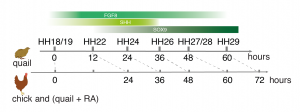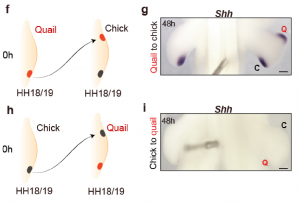Species-specific developmental timing dictates expansion of the avian wing skeletal pattern
Posted on: 4 May 2021
Preprint posted on 3 May 2021
Article now published in Cell Reports at http://dx.doi.org/10.1016/j.celrep.2021.110288
It’s about birds time! Temporal scaling of proximo-distal wing patterning can be set by retinoic acid in quail and chick wing buds.
Selected by Teresa RayonCategories: developmental biology
In this preprint, Holly Stainton and Matthew Towers investigate the differences in developmental pace in proximo-distal wing patterning across birds. In the developing wing of quail and chick, the downregulation of Fgf8 expression, Sox9 onset of expression, and necrotic changes occur at equivalent Hamburger-Hamilton (HH) stages, which correspond to 46 chronological stages in bird development. Similarly, Hoxa11 and Hoxa13 follow equivalent dynamics in both species. However, there is a sustained 12-hour difference in the dynamics of expression of these genes between quail and chick that indicates that quail proximo-distal wing patterning progresses faster in comparison to chick. Strikingly, the growth rates are comparable between the species during the patterning phase.

In this preprint, the authors perform a series of homochronic transplants to investigate what sets the tempo. As the offset in timing is initiated 12 hours after the HH18/19 stage, the authors perform interspecies polarising region grafts prior to any offset in developmental timing. Whereas Shh expression is downregulated after 48 hours in normal quail wing development, Shh expression in quail grafts placed on chick hosts is extended for 48 hours, matching Shh chick expression at HH26. Likewise, when they perform the reverse transplants grafting chick cells on quail, they are able to show an accelerated decrease in SHH expression of the chick graft transplanted in the quail host at 48 hours later. These experiments indicate that the pace of expression is set at the onset of proximo-distal patterning in wing buds, at the time that the chick and quail HH stage is equivalent.
The authors then looked into retinoic acid (RA) signaling, as it is cleared in the distal region of the wing bud by HH21, and could cause the different behaviour between the HH18/19 stage and the subsequent time points. They found that Cyp26b1 levels rise significantly faster in the quail compared to the chick. As Cyb26b1 is the major retinoic acid degrading enzyme, these findings indicate a decreased degradation rate of retinoic acid in the wing bud of larger species. Moreover, by transiently prolonging retinoic acid signalling, the authors elegantly demonstrate that Shh expression timing is delayed in the quail polarising region graft, as the expression is maintained for approximately the same duration as in the host chick polarising region.

To conclude the paper, the authors characterize the dynamics of wing development in turkey. Turkey wings are larger in size than chick, and the preprint shows that they progress with a 12-hour delay in the expression of Shh, Hoxa11 and Hoxa13 compared to chick. As predicted from their findings of the involvement of RA in setting the pace, culturing chick wings with RA from HH18/19 delayed the pace of chick development and matched the length of the chicken wing to that of the turkey at HH21. Altogether, the preprint shows that there is a proportional patterning and temporal scaling in wing bud development between quail, chick, and turkey that can be reset by addition of retinoic acid within the first 12 hours of wing development.
Why I chose the paper and how it moves the field forward:
I’m interested in understanding how developmental timing operates at the cellular level, and this work studies developmental timing in vivo during proximo-distal limb development in birds. Limbs are one of the best characterized developmental systems, and they show a well-defined sequence of temporal events that can be used to investigate developmental tempo. In addition, limbs have undergone extensive evolutionary diversification across species. Moreover, birds are a great model in developmental biology as eggs can easily be collected and cultured, and are amenable for numerous embryology perturbations. Even though chick is the dominant model, reports in quail, zebra finch and emus have provided some interesting developmental evolutionary perspectives (Uygur et al., 2016; Young et al., 2019). I find particularly useful for the of study developmental pace the fact that HH staging is based on morphological features that correspond quite neatly with changes in gene expression programs.
Notably, Stainton and Towers show that developmental timing is proportionately scaled across turkey, chick and quail and demonstrate that RA can delay the timing of wing bud development in quail and chick, suggesting that the degradation rate of RA sets the tempo in the system. This finding resembles the differences in protein degradation observed in mouse and human cells that associate with differences in developmental tempo (Matsuda et al., 2020; Rayon et al., 2020). It would be really exciting to know how Cyp26b1 levels are regulated to modify the degradation rate of RA in their system. Looking forward to their future work!
doi: https://doi.org/10.1242/prelights.28815
Read preprintSign up to customise the site to your preferences and to receive alerts
Register hereAlso in the developmental biology category:
Gestational exposure to high heat-humidity conditions impairs mouse embryonic development
Girish Kale, preLights peer support
Modular control of time and space during vertebrate axis segmentation
AND
Natural genetic variation quantitatively regulates heart rate and dimension
Girish Kale, Jennifer Ann Black
Notch3 is a genetic modifier of NODAL signalling for patterning asymmetry during mouse heart looping
Bhaval Parmar
preLists in the developmental biology category:
BSDB/GenSoc Spring Meeting 2024
A list of preprints highlighted at the British Society for Developmental Biology and Genetics Society joint Spring meeting 2024 at Warwick, UK.
| List by | Joyce Yu, Katherine Brown |
GfE/ DSDB meeting 2024
This preList highlights the preprints discussed at the 2024 joint German and Dutch developmental biology societies meeting that took place in March 2024 in Osnabrück, Germany.
| List by | Joyce Yu |
‘In preprints’ from Development 2022-2023
A list of the preprints featured in Development's 'In preprints' articles between 2022-2023
| List by | Alex Eve, Katherine Brown |
preLights peer support – preprints of interest
This is a preprint repository to organise the preprints and preLights covered through the 'preLights peer support' initiative.
| List by | preLights peer support |
The Society for Developmental Biology 82nd Annual Meeting
This preList is made up of the preprints discussed during the Society for Developmental Biology 82nd Annual Meeting that took place in Chicago in July 2023.
| List by | Joyce Yu, Katherine Brown |
CSHL 87th Symposium: Stem Cells
Preprints mentioned by speakers at the #CSHLsymp23
| List by | Alex Eve |
Journal of Cell Science meeting ‘Imaging Cell Dynamics’
This preList highlights the preprints discussed at the JCS meeting 'Imaging Cell Dynamics'. The meeting was held from 14 - 17 May 2023 in Lisbon, Portugal and was organised by Erika Holzbaur, Jennifer Lippincott-Schwartz, Rob Parton and Michael Way.
| List by | Helen Zenner |
9th International Symposium on the Biology of Vertebrate Sex Determination
This preList contains preprints discussed during the 9th International Symposium on the Biology of Vertebrate Sex Determination. This conference was held in Kona, Hawaii from April 17th to 21st 2023.
| List by | Martin Estermann |
Alumni picks – preLights 5th Birthday
This preList contains preprints that were picked and highlighted by preLights Alumni - an initiative that was set up to mark preLights 5th birthday. More entries will follow throughout February and March 2023.
| List by | Sergio Menchero et al. |
CellBio 2022 – An ASCB/EMBO Meeting
This preLists features preprints that were discussed and presented during the CellBio 2022 meeting in Washington, DC in December 2022.
| List by | Nadja Hümpfer et al. |
2nd Conference of the Visegrád Group Society for Developmental Biology
Preprints from the 2nd Conference of the Visegrád Group Society for Developmental Biology (2-5 September, 2021, Szeged, Hungary)
| List by | Nándor Lipták |
Fibroblasts
The advances in fibroblast biology preList explores the recent discoveries and preprints of the fibroblast world. Get ready to immerse yourself with this list created for fibroblasts aficionados and lovers, and beyond. Here, my goal is to include preprints of fibroblast biology, heterogeneity, fate, extracellular matrix, behavior, topography, single-cell atlases, spatial transcriptomics, and their matrix!
| List by | Osvaldo Contreras |
EMBL Synthetic Morphogenesis: From Gene Circuits to Tissue Architecture (2021)
A list of preprints mentioned at the #EESmorphoG virtual meeting in 2021.
| List by | Alex Eve |
EMBL Conference: From functional genomics to systems biology
Preprints presented at the virtual EMBL conference "from functional genomics and systems biology", 16-19 November 2020
| List by | Jesus Victorino |
Single Cell Biology 2020
A list of preprints mentioned at the Wellcome Genome Campus Single Cell Biology 2020 meeting.
| List by | Alex Eve |
Society for Developmental Biology 79th Annual Meeting
Preprints at SDB 2020
| List by | Irepan Salvador-Martinez, Martin Estermann |
FENS 2020
A collection of preprints presented during the virtual meeting of the Federation of European Neuroscience Societies (FENS) in 2020
| List by | Ana Dorrego-Rivas |
Planar Cell Polarity – PCP
This preList contains preprints about the latest findings on Planar Cell Polarity (PCP) in various model organisms at the molecular, cellular and tissue levels.
| List by | Ana Dorrego-Rivas |
Cell Polarity
Recent research from the field of cell polarity is summarized in this list of preprints. It comprises of studies focusing on various forms of cell polarity ranging from epithelial polarity, planar cell polarity to front-to-rear polarity.
| List by | Yamini Ravichandran |
TAGC 2020
Preprints recently presented at the virtual Allied Genetics Conference, April 22-26, 2020. #TAGC20
| List by | Maiko Kitaoka et al. |
3D Gastruloids
A curated list of preprints related to Gastruloids (in vitro models of early development obtained by 3D aggregation of embryonic cells). Updated until July 2021.
| List by | Paul Gerald L. Sanchez and Stefano Vianello |
ASCB EMBO Annual Meeting 2019
A collection of preprints presented at the 2019 ASCB EMBO Meeting in Washington, DC (December 7-11)
| List by | Madhuja Samaddar et al. |
EDBC Alicante 2019
Preprints presented at the European Developmental Biology Congress (EDBC) in Alicante, October 23-26 2019.
| List by | Sergio Menchero et al. |
EMBL Seeing is Believing – Imaging the Molecular Processes of Life
Preprints discussed at the 2019 edition of Seeing is Believing, at EMBL Heidelberg from the 9th-12th October 2019
| List by | Dey Lab |
SDB 78th Annual Meeting 2019
A curation of the preprints presented at the SDB meeting in Boston, July 26-30 2019. The preList will be updated throughout the duration of the meeting.
| List by | Alex Eve |
Lung Disease and Regeneration
This preprint list compiles highlights from the field of lung biology.
| List by | Rob Hynds |
Young Embryologist Network Conference 2019
Preprints presented at the Young Embryologist Network 2019 conference, 13 May, The Francis Crick Institute, London
| List by | Alex Eve |
Pattern formation during development
The aim of this preList is to integrate results about the mechanisms that govern patterning during development, from genes implicated in the processes to theoritical models of pattern formation in nature.
| List by | Alexa Sadier |
BSCB/BSDB Annual Meeting 2019
Preprints presented at the BSCB/BSDB Annual Meeting 2019
| List by | Dey Lab |
Zebrafish immunology
A compilation of cutting-edge research that uses the zebrafish as a model system to elucidate novel immunological mechanisms in health and disease.
| List by | Shikha Nayar |











 (No Ratings Yet)
(No Ratings Yet)